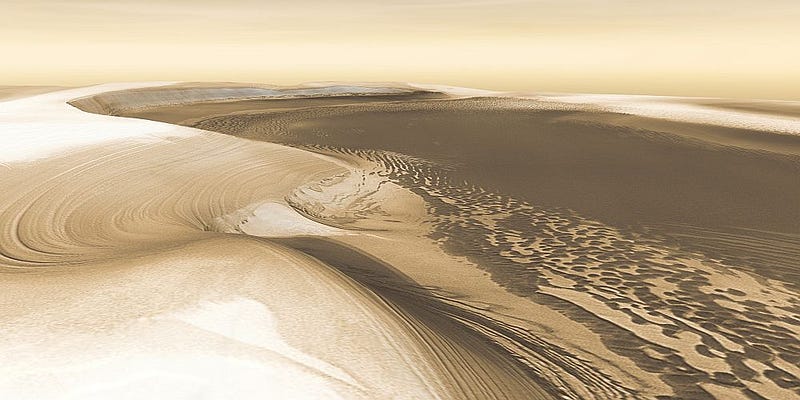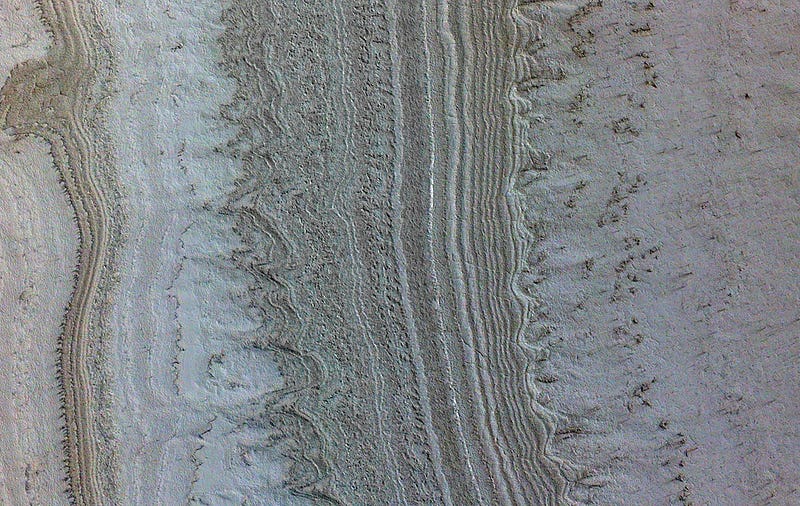# Is Martian Clay Masking Hidden Lakes?
Written on
Chapter 1: The Enigma of Martian Polar Regions
Recent studies suggest that the South Polar Layered Deposits (SPLD) on Mars may contain clay rather than hidden lakes, challenging previous assumptions. A trio of studies has emerged, casting doubt on earlier findings that indicated the presence of liquid water beneath Mars' polar regions, as depicted in simulated terrain images by NASA/JPL/ASU/R. Luk.

In 2018, a team led by Roberto Orosei from the Istituto Nazionale di Astrofisica in Italy revealed data from the European Space Agency’s Mars Express orbiter. The study utilized radar waves to penetrate rock and ice, allowing researchers to explore the geological features beneath the Martian surface. Initial radar images hinted at the possibility of lakes of liquid water hidden beneath the polar caps of Mars, which is often regarded as the most Earth-like planet in our solar system.
However, more recent investigations into the SPLD suggest that what was once interpreted as liquid water may actually be attributed to the presence of clay on Mars.
Section 1.1: The Challenges of Liquid Water on Mars
The Martian environment presents significant challenges for the stability of liquid water. Any droplets that form or reach the surface are likely to evaporate quickly due to the thin Martian atmosphere. Only beneath the surface could water remain in a liquid state. It is believed that small, highly-saline water deposits, comparable in size to thimbles, may exist just beneath the surface. While larger lake-like formations could potentially harbor life, the scientific community remains cautious in its interpretations.
In 2015, findings from the Mars Reconnaissance Orbiter (MRO) suggested that material sliding down slopes indicated the presence of damp sand. However, further analysis revealed that these movements were likely due to dry sand flows, illustrating the self-correcting nature of science.
Subsection 1.1.1: Radar Reflections and the Search for Clays

The SPLD consists of alternating layers of water ice, dry ice, and dust that have built up over millions of years, forming a dense layer of frozen material. While some areas were previously thought to contain water, new studies indicate that these locations may be too close to the surface for liquid water to exist.
Researchers at Arizona State University, including Carver Bierson, investigated various materials that might account for the radar signals observed. They noted, "A radar reflection can be bright due to a large contrast in either dielectric permittivity or electric conductivity." Their research suggests that the brightness could be attributed to clays, metal-bearing minerals, or saline ice located beneath the polar ice sheet.
Chapter 2: Insights from Radar Data
Utilizing data from the Mars Advanced Radar for Subsurface and Ionosphere Sounding (MARSIS) aboard Mars Express, researchers identified numerous radar reflections similar to those caused by ice. This ongoing exploration deepens our understanding of Mars, as noted by Carl Sagan: "There is every reason to think that in the coming years Mars and its mysteries will become increasingly familiar to the inhabitants of the Planet Earth."
Isaac Smith from York University conducted experiments on smectites, a type of clay prevalent on Mars. By exposing smectite samples to liquid nitrogen to mimic Martian polar temperatures, he observed radar signals akin to those detected by the spacecraft. "In planetary science, we often are just inching our way closer to the truth," said Plaut, reflecting on the evolving nature of scientific understanding.
Whether the phenomenon is due to clay or hidden lakes, the radar reflections from Mars hold significant promise for future discoveries. James Maynard, the founder and publisher of The Cosmic Companion, resides in Tucson, Arizona, where he shares his passion for space exploration with his wife, Nicole, and their cat, Max.
Did you enjoy this article? Connect with us on The Cosmic Companion Network for our podcast, weekly video series, informative newsletter, and news briefings on Amazon Alexa!